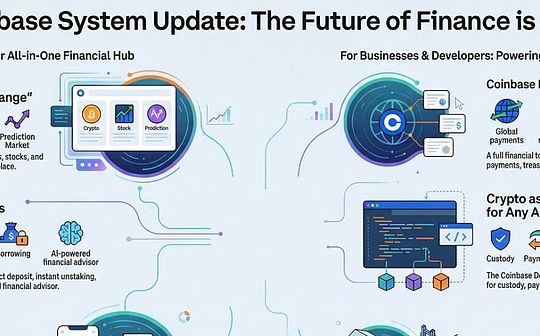
As of March 13, 2025, Bitcoin (BTC) has fallen 3% in the past 24 hours, with the current price of $81,148, and Bitcoin market capitalization (BTC.D) has fallen back to 61.68%.Market sentiment is sluggish, with centralized exchange trading volume shrinking 21% to $7.2 trillion last month, and Wall Street is worried about the “Trump sell-off.”At the same time, technical indicators show an “oversold” state, derivatives market remains resilient, and Bitcoin ETF capital flows show signs of recovery.Under this complex situation, is Bitcoin in a normal adjustment during a bull market cycle, or is it sliding into a deeper bear market?Based on the latest data and multi-party perspectives, this article will systematically analyze the current market and look forward to future trends from three dimensions: short-term oscillation, potential risks and long-term opportunities.
1. Short-term oscillation: logic and support for bull market adjustment
Normal pullback in a bull market cycle
Bitfinex analysts pointed out that price adjustments during the bull market are typical, and the current negative decline may only be temporary fluctuations, rather than the beginning of a long-term bear market.They stressed that Bitcoin trends are closely related to the wider financial markets, especially the performance of stock and bond yields.If global liquidity conditions ease and institutional inflows continue, the support level of $72,000-75,000 may be the cornerstone of the rebound.On March 12, the net inflow of Bitcoin ETFs broke the outflow trend for five consecutive days, with ARK Invest’s ETF performing particularly strongly, indicating that institutional demand has not subsided due to short-term volatility.Analysts believe this may be a signal that fund managers are re-aligning their positions for the Fed’s policy to turn dovishly.
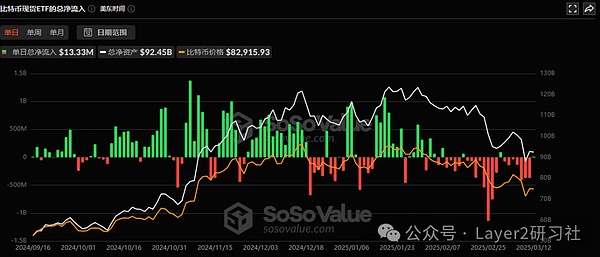
Cointelegraph further supported this judgment by citing analyst Marcel Pechman’s point of view.He believes that Bitcoin’s pullback may be nearing its end due to the stability of derivatives market, weak US dollar and the US budget crisis.Bitcoin fell to a four-month low of $76,700 on March 11, while the S&P 500 fell 6% in a week, and investors’ concerns about a global recession increased.However, the adjustment is closer to the mid-term correction in June 2024 (down 31.5% to $49,220 from $71,940) than the bear market crash at the end of 2021 (down 31.5% to $49,220) .A 30% callback magnitude is not uncommon in Bitcoin history and does not trigger systemic panic.
Technical indicators and resilience of derivatives market
Technical analysis shows positive signals.CryptoQuant analysts said that the market entered the “oversold” range and the selling pressure has been fully released, and even if there is no further sharp decline, it may provide favorable conditions for the rise.In addition, the Bitcoin derivatives market has shown resilience.Pechman noted that despite the price drop, the annualized premium for futures remained at 4.5%, much higher than the level below 0% after the June 2022 crash.The interest rate of perpetual futures financing is close to zero, indicating that the demand for long and short leverage is balanced, and there is no common short-dominated market in bear markets.This is in stark contrast to the scenario at the end of 2021, when the dollar strengthened (DXY rose from 92.4 to 96.0) accompanied investors turning to cash positions, while the current DXY fell back from 109.2 to 104 at the beginning of the year, weakening the hedge appeal.
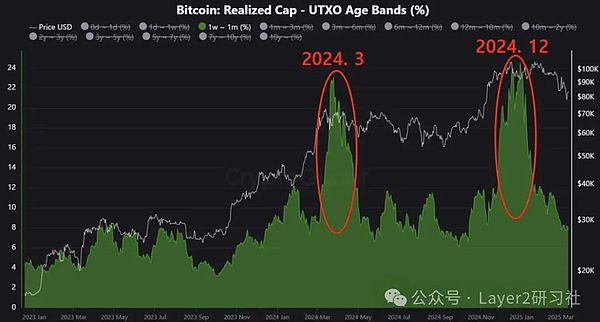
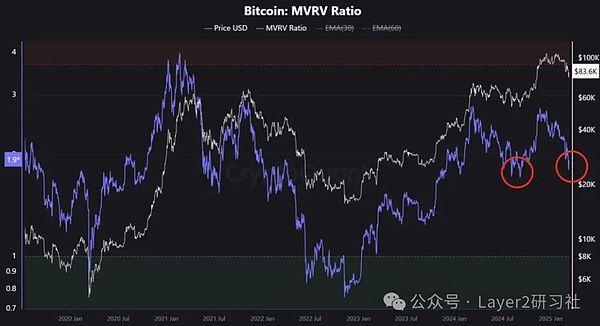
2. Potential risks: macro pressure and extreme situations
Macroeconomic uncertainty
Despite optimism in the short-term indicators, macroeconomic uncertainty casts a shadow on the market.Yardeni Research President Ed Yardeni, the Wall Street “big bull” who once predicted the S&P 500 index would reach 7,000 points, has turned cautious recently.He warned that the “bear market may have begun quietly” and noted that “Trump tariff 2.0” could trigger a lightning crash similar to that of 1962 or 1987.Mars Finance reports also show that Wall Street has fallen into uneasiness due to the “Trump sell-off”, and the “buy on dips” strategy that dominated the market in the past 20 years has been replaced by “locking profits” and “waiting and watching”.Roundhill Investments CEO Dave Mazza described the current purchase as “buying discounted tickets for unknown shows”, full of high risks and uncertainty.
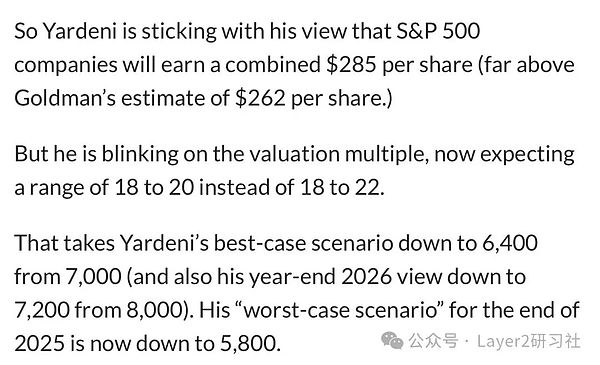
Robert W Baird & Co. Managing Director Ted Motson said that the market has entered a “guaranteed model”, especially in the fields of technology and encryption, and is facing the common cyclical headwinds in the spring.Centralized exchange trading volume fell 21% to $7.2 trillion, further reflecting liquidity pressure.If expectations of a global recession are fulfilled or the trade war escalates in full swing, the crypto market may face greater impact.
Risk of loss of key support levels
Although CryptoQuant regards “oversold” as a buying opportunity, a technical rebound may be suppressed if investor sentiment turns to extreme panic.Historical data show that panic selling is often accompanied by liquidity crises and collapse of confidence.If Bitcoin falls below $74,000 and triggers a chain reaction, short-term fluctuations may evolve into a longer bear market.Bitfinex’s optimistic forecasts rely on improvements in global liquidity, but if this premise is not realized, the risks will be significantly amplified.
Eugene Ng Ah Sio proposed a more specific downward scenario from a technical level.He predicts that if MicroStrategy sells out at a massive scale, Bitcoin could fall to $52,000 or even $25,000, down 36% and 70% respectively.For Solana (SOL), he believes that $80 is the key support level, and if it falls below it, it may fall by $25, a drop of more than 80%.Although these extreme bottoms are low, they are not impossible under macro deterioration (such as institutional fund withdrawal or liquidity depletion).The assumption of $25,000 is staggering, but it is still within the reasonable range compared to the 2022 bear market low of $16,000.
BTC.D’s Misconceptions and the Impact of ETH
BTC.D (Bitcoin Market Value Percentage) is often misread as a market vane.Currently, BTC.D has fallen back to 61.68%, and some people are looking forward to the start of the “copy season”.However, the decline in BTC.D is often the result of “BTC rally slowing + altcoin rise” rather than the reason.Its trend is largely driven by Ethereum (ETH) and is highly correlated with the ETH/BTC exchange rate.Eugene has moved ETH out of its portfolio, showing caution about ETH’s short-term outlook, which may further drag BTC.D, but may not necessarily indicate an altcoin boom.If investors rely solely on BTC.D to judge trends, they may ignore the dominant role of ETH and the real market dynamics.
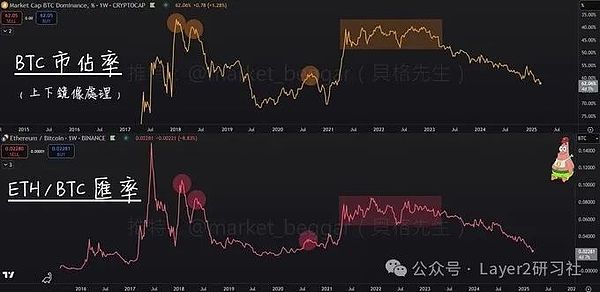
3. Long-term Opportunities: Policy Turnover and Market Potential
US policy shift: From regulatory hostility to strategic reserves
The U.S. government’s attitude towards digital assets is undergoing a historic shift, injecting new momentum into Bitcoin’s long-term prospects.On March 7, President Trump signed an executive order to formally establish the “Strategic Bitcoin Reserve” and “Digital Asset Stockpile”, marking the first time the United States regards Bitcoin as a strategic asset, analogous to traditional reserves such as gold.White House officials called it “Fort Knox in the digital age”, emphasizing the scarcity and security of Bitcoin, believing that its fixed supply (21 million) gives strategic value.The executive order stipulates that the reserved Bitcoin will be derived from criminal and civil confiscation assets and cannot be sold, and is intended as a means of long-term storage of value.This policy reversed the regulatory hostility towards the crypto industry during the Biden administration and reflected Trump’s determination to fulfill his campaign promises – he had promised to build the United States into a “crypto capital.”
On March 11, Senator Cynthia Lummis (R-Wyoming) reintroduced the BITCOIN Act, proposing that the U.S. government purchase 1 million bitcoins (about $80 billion at current prices) over the next five years and write Trump’s Bitcoin reserve plan into law.The bill will also raise funds through the Federal Reserve’s net income and the Treasury issuance of new gold certificates (based on current market prices).Lummis said the bill aims to “harness the full potential of digital innovation to solve national debt problems while maintaining a competitive advantage in the global economy.”This legislative trend suggests that the United States may further expand its Bitcoin holdings and consolidate its leading position in the global digital asset race.
Macro liquidity easing: potential catalyst for global central banks
Improved macro liquidity may be another major driving force for Bitcoin’s long-term rise.Arthur Hayes posted on X platform that current market adjustments are normal in a bull market, and he predicted that Bitcoin may bottom out around $70,000, down 36% from an all-time high of $110,000, which is not uncommon in a bull market cycle.He further pointed out that stock markets (especially the S&P 500 SPX and the Nasdaq NDX) may enter a “free decline” phase, triggering a further slowdown in the global economy.However, this pressure may prompt major central banks to take action.Hayes expects the Federal Reserve, the European Central Bank and the Bank of Japan to introduce easing policies to stimulate their respective economic recovery.
Hayes’ analysis provides a macro perspective on Bitcoin’s long-term potential.The implementation of loose policies usually means interest rate cuts, asset purchases or quantitative easing, which will increase market liquidity and reduce risk-free interest rates, thereby pushing up the price of risky assets.Bitcoin, as an anti-inflation asset, tends to perform strongly in a liquidity-easing environment.For example, the Fed’s ultra-loose policy in 2020-2021 drove Bitcoin to surge from $10,000 to an all-time high of $69,000.Hayes recommends investors “mass entry” at this stage, and although they may miss the absolute bottom, they can avoid long-term shocks and potential unrealized losses.For more cautious investors, he recommends waiting for the implementation of loose policies of major central banks before increasing capital investment to reduce risks.
The process of institutionalization accelerates: the integration of banks and blockchain
The shift in U.S. policy is not limited to government reserves, but may also drive a broader process of institutionalization.On March 12, Forbes published an article pointing out that digital assets have moved from the edge of the financial system to the core, and traditional banks are increasingly interested in the crypto market.The article proposes that banks in the United States should be allowed to hold mature digital assets such as Bitcoin and Ethereum, and manage risks through diversification, hedging strategies and strict exposure restrictions.Banks have responded to volatility in foreign exchange and commodity markets, and similar tools are fully suitable for crypto assets.In addition, blockchain technology can optimize cross-border payments, reduce transaction costs, and drive financial institutions to move towards true 24/7 operations.This modernization potential may attract more banks to enter the market, further enhancing the market legitimacy and liquidity of Bitcoin.
The first crypto summit held by the White House on March 7 also sent a positive signal.Trump expressed support for Congress’s legislation on stablecoin and crypto markets at the summit, calling it a “huge opportunity for economic growth and financial innovation.”Participants included Michael Saylor of MicroStrategy and Brian Armstrong of Coinbase, showing government willingness to work with the crypto industry.”The U.S. government is now a holder, or even a buyer of Bitcoin, which will prompt other countries in the G20 to see Bitcoin as the successor to the gold standard.” This trend could trigger a global “bitcoin reserve race” that further boosts its long-term value.
4. Conclusion and investment advice
For investors, the coronavirus situation is both a challenge and an opportunity.It is wiser to maintain flexibility before clarifying trends than to blindly buy the bottom or sell.Short-term traders can pay attention to the gains and losses of the $74,000-76,000 support level, and judge the rebound timing based on the ETF capital flow and DXY trend.Long-term investors should focus on policy trends and institutional behaviors to avoid being disturbed by short-term fluctuations.As Ed Yardeni said, a bear market may quietly come, but Bitfinex’s confidence and derivatives market resilience are also reminding us that the story of a bull market may be far from over.
The next step for Bitcoin depends on the direction of the global economy.At the intersection where the decline and hope are intertwined, prudence and patience may be the best choice at the moment.








